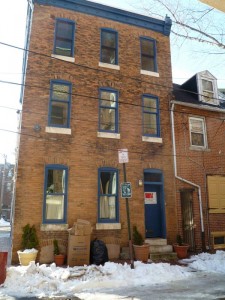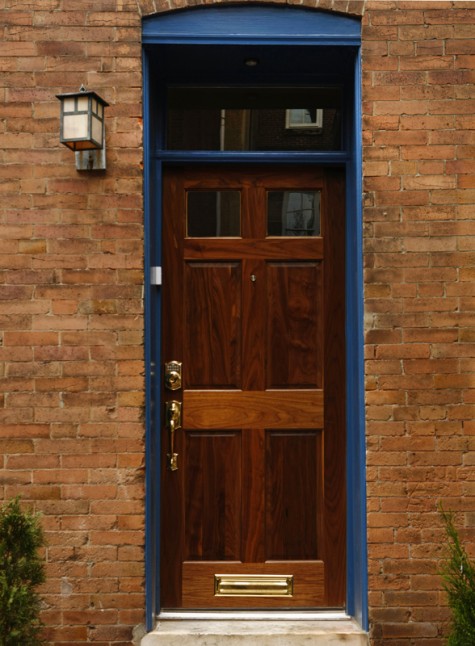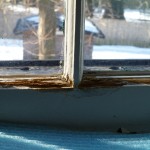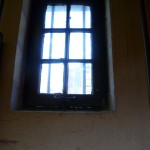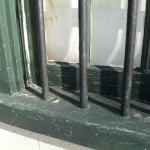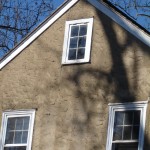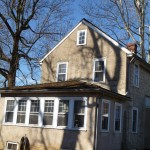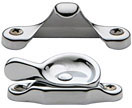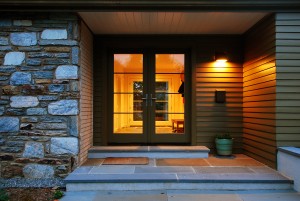The fourth installment in a 5-part Examiner.com series featuring Myers Constructs. Read the story Older or Historic Door Restoration here.
doors
What a Difference a Door Can Make
Many times, a small change to a home can make a huge improvement.
In the case of this city home on a very old alley-sized street, we changed a whole lot of what is inside. But from the street, all you can see is the change we made to the front door.
The “before” photo shows that it used to have a solid slab door with bland and broken knobs and locks. This was not an original door. There was nothing nice or welcoming about it. It also leaked horribly.
The “after” photo shows the pre-hung walnut door and new brass hardware we installed. It’s not an expensive door, by any means. We also installed some puck lighting at the top of the jamb at the transom window.
Now, when guests visit or the homeowners come home, they are greeted by a warm, well-lit, shiny new door that says “Welcome Home!”
You can see some other nice examples of doors in old homes here
Home Maintenance Tip: Air Leaks
This is the best time of year to locate air leaks in your older home. You will know you have them if you can feel drafts, or if your heater is working too hard.
Many people who live in older homes accept the discomfort of leaky windows and doors as “just the way it is” when, in reality, the fixes are very easy and inexpensive to make.
Start by taking a quick tour of your house and identifying the leaks and cold rooms; make a list of those you find. The typical areas of air leaks are any penetration in the “skin” of your home. That could mean a window or door, or a pipe or wire penetrating your home’s walls.
Then, tackle your list one leak at a time to reduce energy use and heating/cooling bills and increase the comfort of your home.
Often, simple chores like caulking, sealing with spray foam or a gasketing system can fix the problem in just a few minutes. If they can’t be fixed that quickly or easily, if a window or door really needs to be replaced, now is the time to start your springtime fix it list. Other less considered sources of air leaks are attic hatches and plumbing trouble doors. Believe it or not, these should be as well sealed (or better) as the doors and windows in your house. Typically, they are nothing more than a plywood sheet = very leaky! Gasketing should be around each of these to prevent air leaking, but still maintain easy use and access. This requires a bit of skill to do well, so call us when you have your fix it list and we’ll get these things done for you.
Oh Baby, It’s Cold Outside
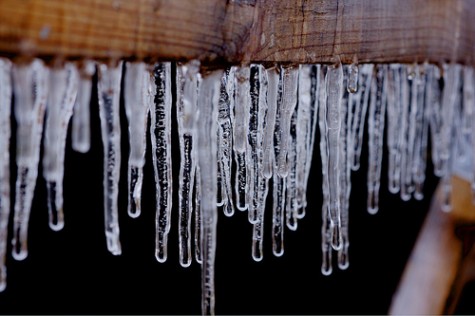
With temps hovering in the 30s all week — and it’s not even officially winter yet! — you may be noticing drafty windows and inefficiencies in your heating system. If your home needs to be more tightly buttoned up this season to stay cozy, give us a call. We can help you choose the right products and suppliers. Act quickly if you want to take advantage of tax rebates ending on 12/31/10.
Image: Emery Way
Older Homes – More Energy Efficient Than You Think
Older homes tend to get a bad rap for being energy inefficient. The truth is, many older homes have built-in energy-efficient systems that a homeowner should learn to use and, if possible, enhance. Here are some fake rolex examples of what I mean:
A stone or brick home with thick walls will retain heat in the winter and cool in the summer by way of its mass. Often, the older home will also have small windows on the third floor or attic. These are meant not only to allow light into the house, but also to allow hot air out in summer. Opening these small windows creates negative pressure inside the house, which then draws cool air from the basement. This is natural cooling at work. That’s because a basement’s mean temperature is between 60 and 70 degrees in summer. Utilizing this cooling air convection, combined with the thermal mass of the brick or stone home, means many of these homes can go several days at a time during a heat wave and not require any artificial air conditioning or cooling.
Since it’s heating season, we should also focus on some “passive” methods for making and keeping an older home warm.
Sash locks — These are the small closures on your double-hung windows you turn to lock them shut. You probably think they are for security, but they are really there to push the two sashes tightly into the sash frame and also to pull the sashes tightly together. This small piece of hardware makes your older wooden windows much more efficient by creating a tighter seal. Many older double-hung windows have not been properly maintained over the decades. The top sash might be stuck with paint, or the sash frame may be “out of square.” Other common problems are weights and chains that have failed. All of these problems can be fixed with some TLC and good carpentry. Happy to help; just give us a call.
Special Reasons to Think Windows and Doors!
Winter is right around the corner … now is the time to think windows! In addition to energy tax credits that are currently in place, you can save up to $550 with a mail-in Live Smart Rebate when you replace your old windows or patio doors with select Weather Shield® products with Zo-e-shield® glazing before 12/31/10. And, when you purchase a window-replacement project worth at least $10,000 from Myers Constructs (choose from select brands available), you’ll receive a complimentary home BPI energy-efficiency audit (value: $500). This test will identify areas within your home that may be causing you to spend more than you need to on your monthly utility bills.
Call us at 215.438.6696 for details on how to qualify for these exciting offers.
Welcome! A Great Entryway We Helped Create
Here is an example of a great entryway we helped create.
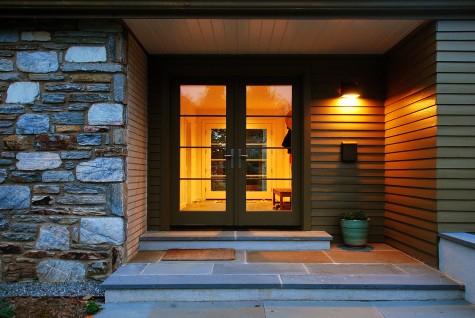
This used to be an open breezeway, unsuited for four season use. Now its a warm welcoming entryway with radiant heat in the slate flooring. These doors let in a lot of light but are super insulated.
A new life for your space. A better life for you.

